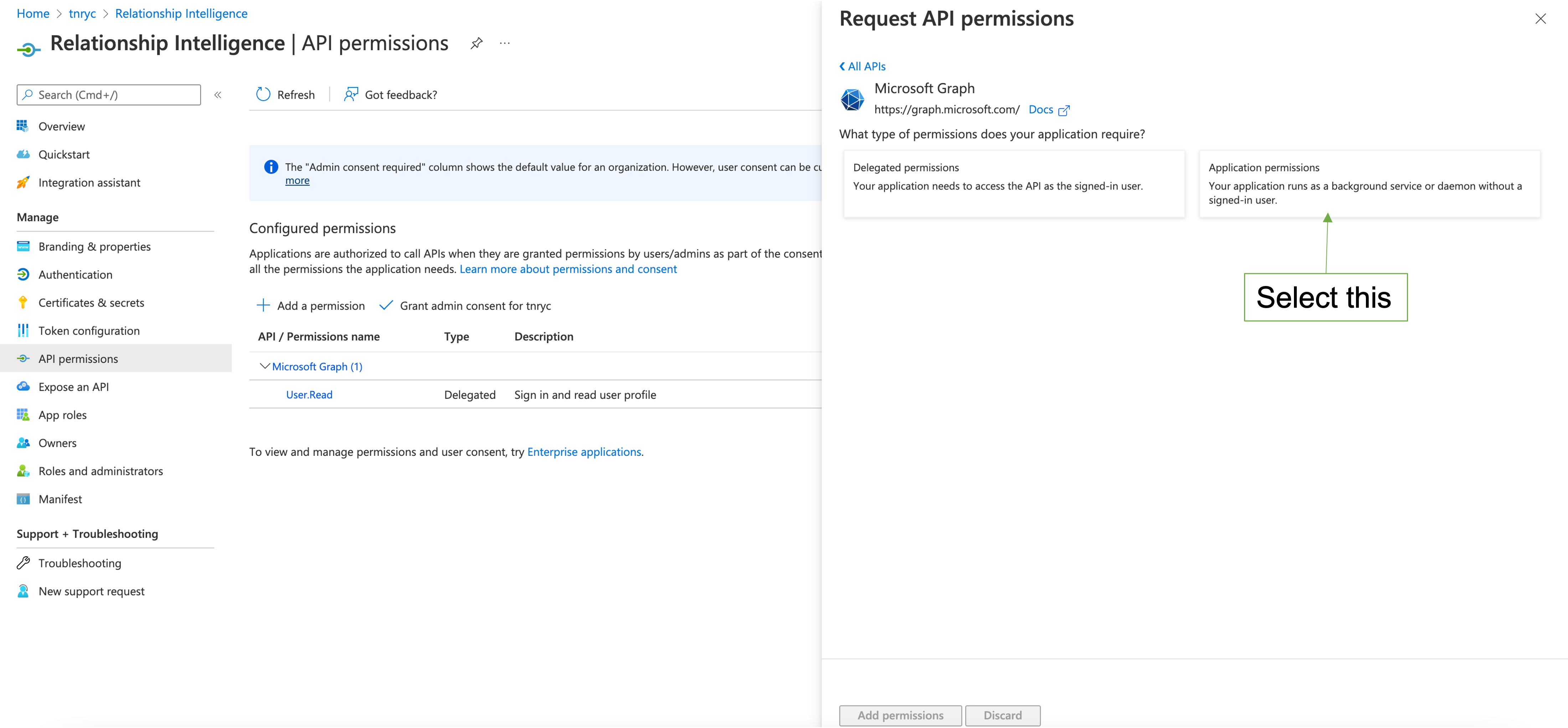
- SAP Community
- Products and Technology
- CRM and Customer Experience
- CRM and CX Blogs by SAP
- SAP Sales Cloud Relationship Intelligence Setup - ...
- Subscribe to RSS Feed
- Mark as New
- Mark as Read
- Bookmark
- Subscribe
- Printer Friendly Page
- Report Inappropriate Content
Currently, we only support integration with Office 365 hence this is a prerequisite for this solution.
Please make sure you refer to all these blogs for end-to-end setup.
- Setting up your Application and Distribution List/Group in the Azure portal (This Blog)
- Generating Password Protected Self-Signed Certificate using open SSL
- Setting up Relationship Intelligence in SAP Sales Cloud
Setting up your Application in Azure is one of the first steps that you would need to perform in Relationship Intelligence. Ensure you have an Azure account with an active subscription.
There are 3 important steps in this and I will try to cover the steps you must follow with screenshots.
- Application Registration
- Grant API Permission for Application
- Create Distribution List/ Group
- Application Registration: Log in to your Azure portal using your admin credentials and go to Microsoft Entra ID

Azure Portal Home Page
Once you are in Azure Active Directory under Manage, Select App Registrations and then click on New Registration

Azure New Registration
While registering the application using any suitable Name, select supported account type as Accounts in this organizational directory only, and since using Redirect URI is optional it can be skipped. Then Click on Register.

Application Registration Details
Once the application is registered it will take you to an overview page where you can see all the details related to the application, such as Application ID and Tenant ID. These will be required later on while creating the server connection inside the Relationship Intelligence administration page.

Application Overview
2. Grant API Permission for Application
Within the application under Manage select API Permission and click on Add permission. Once you click on Add permission, you will see a pop-up - Request API permission.
Here select Microsoft Graph API -> Application Permission and then search and add the below permissions
Calendars.Read
Group.Read.All
GroupMember.Read.All
Mail.ReadBasic.All
User.Read.All
Once you add these APIs make sure you Grant Admin Consent






3. Create Distribution List/ Group :
You must ensure you have a valid group created. Relationship Intelligence monitors only those email addresses maintained in the group.
To create a group go to the Azure Active Directory and under Manage go to Groups and click on New Group

Create New Group
While creating the group ensure that you select group type Microsoft 365 and membership type as Assigned. Ensure that the domain is the same as the one you that you have used while registering the application in the Azure portal

Create New Group
Once created make sure you have added members to the group(of course also belonging to the same domain). Add only those members whose mailbox you wish to monitor.

Created Group

Adding Group Members
With the above 3 steps, the Azure Side setup would be completed. There is one more step to be done in Azure which is to upload the certificate for authentication, which requires you to generate a password-protected self-signed certificate. Please do share your feedback and thoughts in the comments.
You can refer to my Next Blog post Generating Password Protected Self-Signed Certificate using open SSL for more details on certificate generation and upload.
- SAP Managed Tags:
- SAP Sales Cloud,
- SAP Intelligent Sales Execution,
- C4C Sales
You must be a registered user to add a comment. If you've already registered, sign in. Otherwise, register and sign in.
-
Business Trends
270 -
Business Trends
11 -
chitchat
1 -
customerexperience
1 -
Event Information
256 -
Event Information
18 -
Expert Insights
30 -
Expert Insights
51 -
Life at SAP
133 -
Life at SAP
1 -
Product Updates
666 -
Product Updates
24 -
SAP HANA Service
1 -
SAPHANACloud
1 -
SAPHANAService
1 -
Technology Updates
453 -
Technology Updates
15
- CRM Basic Technical Info for ABAPers in CRM and CX Blogs by Members
- Get Started with Embedded SAP Analytics Cloud in SAP Sales & Service Cloud (C4C) in CRM and CX Blogs by SAP
- Navigating the Modern Sales Landscape: The AI Advantage, SAP Sales Cloud Intelligent Sales Add-on in CRM and CX Blogs by SAP
- Sales & Service Cloud - Intelligent Sales Add-on – 2402 features in CRM and CX Blogs by SAP
- SAP and SalesForce Custom Integration flows in CRM and CX Questions
| User | Count |
|---|---|
| 4 | |
| 2 | |
| 2 | |
| 2 | |
| 1 | |
| 1 | |
| 1 | |
| 1 | |
| 1 | |
| 1 |